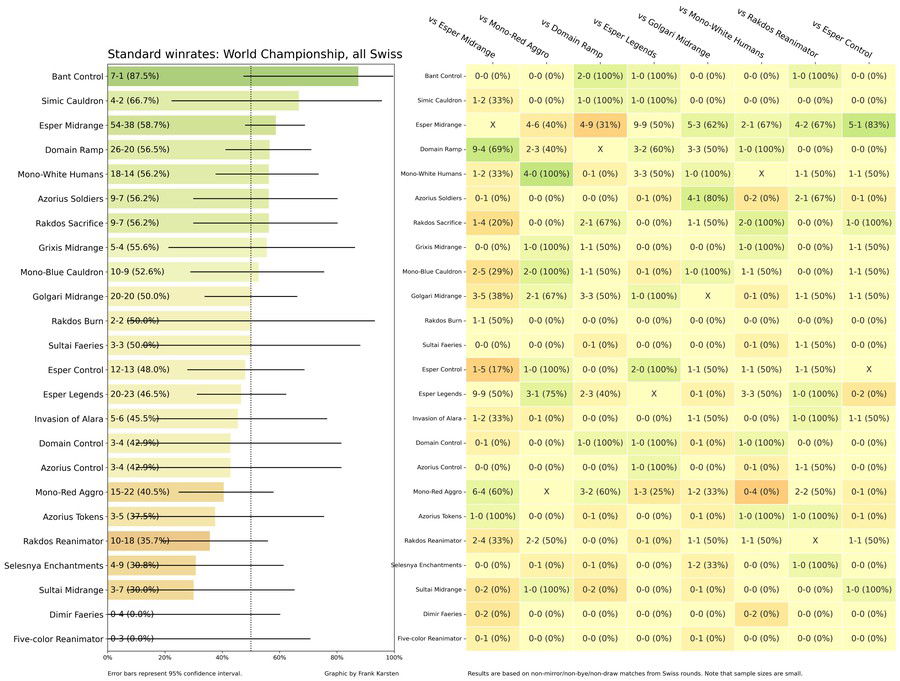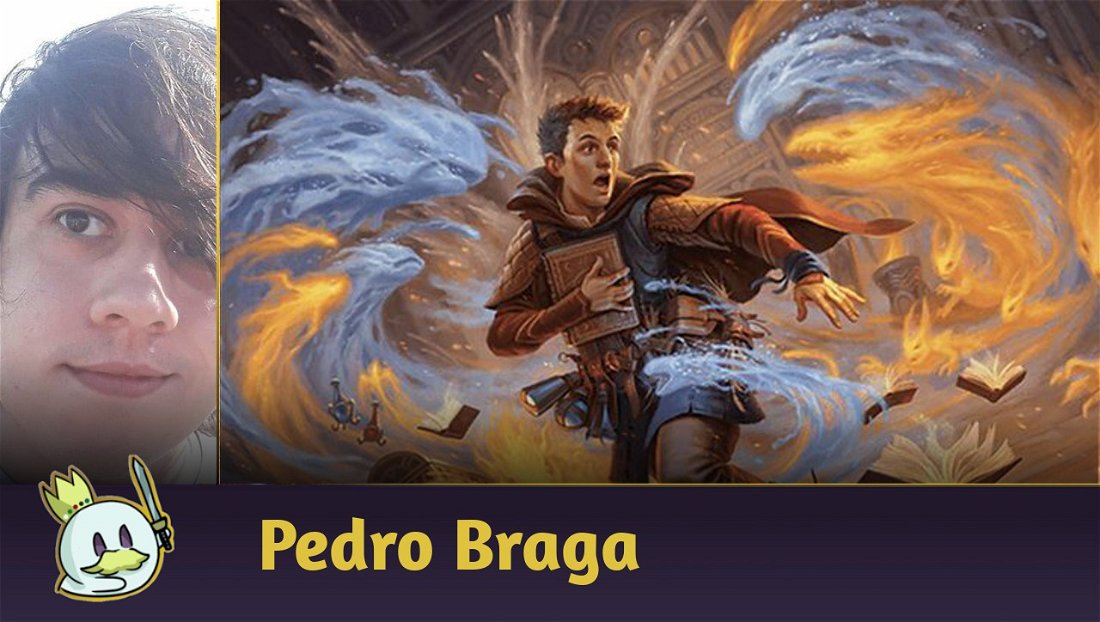Magic: The Gathering's 2023 World Championship has come to an end. As in any major professional event, deck choices and lists that stand out gain prominence in local events, online, or in Magic Arena ranked matches.
However, the Worlds has some variables, such as the inclusion of the draft in the first rounds of both days, which don't make players' standings a direct sign of their deck's performances. In this article, we review the Standard rounds winrates, and evaluate the winners and losers of the event, and how they could impact the Metagame in the future.
Ad
We will use the table presented by mathematician Frank Karsten the night before the Top 8. However, there are some points that we must consider.

Despite this being the most important tournament in the competitive Magic scene, its sample size is small: 105 players, which doesn't come close to the number that some independent online events get registered.
On the other hand, sampling winrates are more consistent here. After all, these are the 105 best players in the world in 2023. Each has ostensibly prepared for the tournament and, in theory, has the most comprehensive experience and knowledge about the format and its decks - therefore, it is common for the lists that produce the best results here become the standard that every player seeks in the following weeks.
The World Championship has a great influence on Standard and the format's evolution. The weeks following it tend to popularize certain archetypes that caught attention during the matches, and force other strategies to adapt to remain viable against a new Metagame that is being formed.
The World Championship's Winners
Esper Midrange
Esper Midrange was the tournament's most played deck, and its numbers present it as one of the best options for Standard today. While its matchups against Mono Red Aggro and Domain Ramp seem unfavorable, the archetype has held steady against most other strategies.

Its card pool is a stack of the best Standard has to offer today: from useful counterspells like Make Disappear, value engines like Wedding Announcement, and a dozen creatures and Planeswalkers that dominate the game if aren't dealt with, such as Raffine, Scheming Seer, Sheoldred, the Apocalypse and The Wandering Emperor.
Added to access to an efficient mana base, Esper Midrange should become the deck to beat in the coming weeks, and it is likely to remain in this space for a long time, as its game plan is comprehensive and adaptable to deal with the other strategies on the spotlight right now.
Domain Ramp
Domain Ramp was already on the rise prior to the release of Wilds of Eldraine, and the changes that the new expansion brought to Standard put it in an even more favorable spot. Up the Beanstalk is an excellent value engine alongside so many high-cost spells, and Virtue of Persistence wins the game on its own if left unanswered, especially if it reanimates bombs like Atraxa, Grand Unifier and Sheoldred, the Apocalypse

Speaking of Atraxa, Standard's stance towards its best creature has changed a lot from last season: the Phyrexian angel no longer wins games on its own after being cheated in play with The Cruelty of Gix and the like - these strategies had horrendous results in the tournament. Instead, she wins the match when you manage to hold the game and maintain resource parity to bury the opponent in card advantage the moment she enters the battlefield.
Ad
Given its very positive winrate against Esper Midrange, and where nothing that Esper does to better adapt this matchup cannot be responded to in kind by Domain Ramp, I believe that these two strategies will compete for the title of best deck in the format, while other archetypes will find the gaps between these two to have their spot in the Metagame.
Soul Cauldron
Although the sample size of the Mono Blue version is larger and presents an average to positive result, the Simic variant of the Agatha's Soul Cauldron combo demonstrates the adaptability potential of the archetype.

If you haven't encountered one of these in ranked games yet, the list's game plan involves using Agatha's Soul Cauldron to give some creature the abilities of Sleep-Cursed Faerie and Kami of Whispered Hopes, so it can then generate three or more blue mana and use two to untap itself, thus generating infinite mana.

With infinite mana, the player can use Realm-Scorcher Hellkite to deal infinite damage, or Hypnotic Grifter for infinite looting and find a wincondition or attack with an arbitrary amount of power.
What makes a combo that requires so many steps and pieces a viable option in the format, and one of the winners of the Worlds Metagame, is that both versions are hard to interact with, either because we are in an environment where players compete over who plays under and who plays for value, or because dealing with Agatha's Soul Cauldron requires a mix of removals and disruption that aren't as favorable against the rest of the format.
Maindeck artifact hate are little needed today, interactions with the graveyard are mostly incidental with Lord Skitter, Sewer King or Graveyard Trespasser, and it naturally plays well against removals because the creatures only need to have a +1/+1 counter to close the combo if both pieces are exiled with Agatha's Soul Cauldron.
The Simic version demonstrates another step in the natural evolution of this archetype, and it certainly won't be the last variant we see of the combo. However, due to the high need for clicks and interactions required in Magic Arena or MTGO to execute the combo, I believe that it will not be as common in ranked matches, unless it grows in the Metagame to the point of predominating in Challenges and other large tournaments.
Mono White Aggro
"Go wide" Aggro have an advantage in the Metagame as long as Sweepers are down in the format - which, currently, they are. In the Worlds, the "Aggro to beat" seemed to be Mono Red, and most of the choices in the maindeck and sideboard seem more focused on gaining extra breath or removing individual creatures to bury the opponent with value in later turns, than dealing permanently with numerous threats.

Ad
In this sense, Mono White Aggro capitalizes well on the Metagame's lack of adaptation, with the ability to prey on those looking for a better winrate against Esper and Domain Ramp, becoming the format's main strategy for "playing under".
However, its objectivity and speed is also its biggest weakness: as new techs emerge, the more difficult it becomes to maintain a linear plan in Standard. Mono Red went poorly at the event for the same reason, and if the Metagame starts to see Mono White as the metric, more sweepers and more specific answers will be included, and will reduce its share.
Azorius Soldiers
In this sense, Azorius Soldiers seems better positioned in the medium term, despite the risk of losing its potential if new releases do not bring relevant support to the archetype. While it has the same "go wide" proposal as Mono White Humans, this strategy trades speed for a more adaptable game plan, with greater ability to play for Tempo, or to remain relevant as the game drags on.

As the Metagame develops, it becomes clearer to Soldiers that their payoffs aren't necessary at all because their creatures are already pretty decent on their own. Even Harbin, Vanguard Aviator is a decent two-drop that ensures your creatures bypass your opponents' when the board is locked on both sides. Therefore, the deck is betting on stronger standalone cards instead of typal synergies.
Among the "go-wides", and Aggro as a whole, Soldiers look like the most promising option for the format in the coming weeks!
Rakdos Sacrifice
Rakdos Sacrifice is a strategy that people have been trying to make work since the release of Oni-Cult Anvil, but it has never demonstrated significant results in the Metagame, and its results in the World Championship should put more of a spotlight on it.

Wilds of Eldraine gave the archetype two useful payoffs: artifacts are the main category of permanents the deck seeks to sacrifice, which fuels Syr Ginger, the Meal Ender, which in addition to deflecting Go for the Throat, cannot be targeted by The Wandering Emperor.
Furthermore, Rakdos Sacrifice has several cards or interactions that put two or more permanents into play in the same turn, and make Goddric, Cloaked Reveler a threat and excellent mana sink for longer games.

Another highlight is Urabrask's Forge, which is not only the Wedding Announcement that red has at home, but also interacts well with Vraan, Executioner Thane, or any another card that benefits from its sacrifice effect, in addition to punishing the opponent's sweepers.
Overall, the lack of interaction with artifacts on the sideboards today makes Rakdos Sacrifice a solid option for ranked play and/or tournaments. Like other archetypes that have benefited from the current Metagame, it is more difficult to interact with than traditional strategies. However, it also requires certain specific setups to work at its best.
Ad
Bant Control
Bant Control is an anomaly: the winrate of UWx Control decks was average to poor at the event, they don't stand out as much in Challenges and Leagues, but Greg Orange achieved the highest winrate in Standard rounds with this list.

Up the Beanstalk is the pillar of this archetype and, perhaps, the card that made it succeed where the other variants failed. Turning all your heavy drops into a draw, without any concession to the resources in your hand, and even with triggers that stack up with multiple copies in play, makes prolonging even more advantageous.
Its future, and that of other Control decks this season is uncertain - the Metagame does not seem favorable for this category. However, the Bant version seems the most accurate today in correcting the inherent flaws of the archetype in this format without the need to lose consistency.
The World Championship's Losers
Golgari Midrange
Golgari Midrange is in a sensitive position: it is the literal middle ground of the tournament, with a 50% winrate. However, I consider it one of the losers due to the number of players who played it, coupled with how bad its matchup against Esper Midrange and Domain Ramp, two of the main competitors in the coming weeks, was.
The decline in relation to results and attendance at last week's events is notable. From certain perspectives, the feeling is that Golgari Midrange is too fair compared to the other value stacks in the current Standard, while having trouble dealing with the go-wides that, in theory, will put these decks in check.
I don't see it as a strategy that will disappear from the Metagame, but concessions will be necessary to define the space in the format that its players intend to occupy.
Esper Legends
Esper Legends had a worse conversion than expected, with enough sampling to see that its position in the Metagame is not as good as it appears. On the other hand, its matchup against some of the standout strategies is balanced, or not so bad as to be an auto-loss, which still makes it a viable option in the coming weeks.
Mono Red Aggro
Mono Red is a ubiquitous strategy in Standard, regardless of its position. Its game plan is objective, the matches are quick, and there is always the possibility of having an absurd start to the game and/or the opponent stumbling, and it wins the game quickly. Its very presence is the compass that defines which strategies are viable.
Its overall winrate in the event was poor, the Metagame was prepared to take it on, but while several matches seem polarized towards Mono Red's negative side, the games against Esper Midrange and Domain Ramp were good enough to keep it as an viable option.
Reanimator
Resolving an Atraxa, Grand Unifier early is no longer a game-winning play on its own. In addition to the incidental graveyard hate that cards like Lord Skitter, Sewer King brought to some decks, the most successful strategies in Standard today can play at par with the value that Atraxa provides, or can play quickly and under, to point to make it irrelevant, or cast their own Atraxas.
Ad
Reanimator variants have generally had poor results and have become a dated proposition for Standard right now.
Domain Cascade
Domain Cascade suffers from the same problem as Reanimator: everything it does can be answered and/or does not generate enough value compared to the other card advantage-oriented archetypes that we have at the top. Its deckbuilding concessions are also too restrictive to give it a significant advantage in Best of Three environments.
The Invasion of Alara combo with Bramble Familiar is very efficient when your opponents don't have the appropriate answers, and Domain Cascade's sideboarding is so sensitive that it makes it an almost linear strategy, and easy toboth read and prevent.
Enchantments
Enchantments preys on strategies that require a setup to work, while also requires a few turns with little or no interaction to explode. This is not the case in Standard today: the most favored decks have a decent number of removals, Wedding Announcement, Leyline Binding, Virtue of Persistence and Virtue of Loyalty make enchantment hate a mandatory slot in the maindeck or Sideboard, and Aggro can force some unfavorable trades too soon.
Azorius / Esper Control
The big problem with Control decks today is the fact that they cannot keep up with the card advantage that other permanents generate. Every permanent that other lists run creates added value for coming into play or remaining in play, and instant-speed spells, like Memory Deluge, can't keep up.
Given Greg Orange's results with his Bant variant, it seems that the answer for Control to have more space in the Metagame is to look for more permanents that generate recurring card advantage for a reasonable cost, such as Up the Beanstalk. However, regarding the traditional versions, the results in the World Championship were poor, and indicate an inability to deal with the best decks in the format.
Faeries
If we aggregate all the variants, Faeries had one of the worst results of the tournament. Its combination of typal synergy with variants of powerful cards, but dependent on having a faerie in play, reveals the archetype's inability to establish a solid strategy that is on par with other competitors in its category: it is too slow to capitalize on cards like Ego Drain, too reliant to be able to come back well from a sweeper, and the choices of cards outside its main type make it just a worse version of Dimir Midrange, which also dropped in popularity post-Wilds of Eldraine.
Conclusion
Standard remains in constant evolution. With the Worlds results, we have a broader picture of which decks work and which are declining in the post-Wilds of Eldraine format. In the coming weeks, we are likely to witness new adaptations to Challenges and other tournaments as the competitive Metagame solidifies.
Thanks for reading!







— Comments0
Be the first to comment